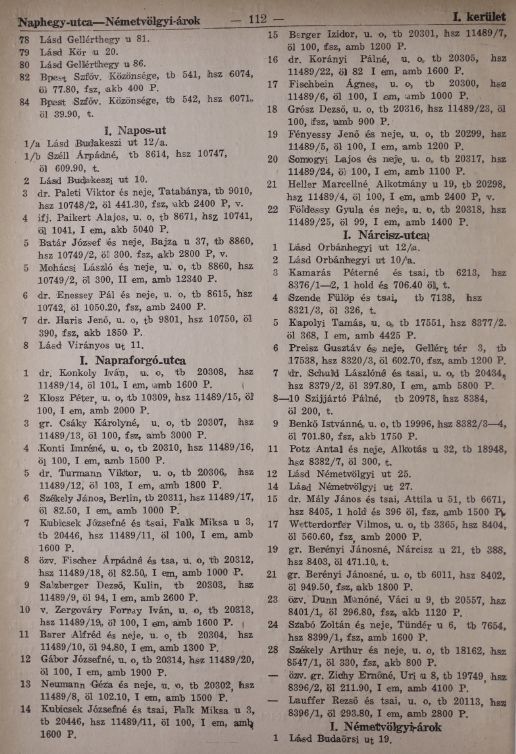Residents and houses
The below document shows the name list of those original owners who bought the house sin 1931. In majority they belonged to the middle class, like army and police officers, bank clerks, wholesalers, etc. During the decades the owners changed several times, with the exception of one villa.

Original owners
https://library.hungaricana.hu/hu/view/FszekCimNevTarak_18_016_01/?pg=157&layout=s&query=Napraforg%C3%B3
The change of owners started at the end of the 1940s when some of the original owners sold its house due to different reasons (for example the owners of house no. 4 emigrated). At the beginning of the 1950s several owners were expelled (for example the Zichy family in no. 20, police officer Géza Komáromy and his family in no. 19), and the house was handed over by the state to a new owner. In the period of housing shortage cotenants were placed into some of the houses beside the owner (for example into the houses no. 3, 5, 9, 10 and 12). Some villas were occupied by unauthorized inhabitants (for example no. 15).
In several cases the house was broken up physically among the new and original inhabitants. In many cases the detachments changed the inner layout, as well as the external facade of the building. In order to enlarge the too small ground-space, annexes were attached to the house or the open terraces were built up. As the houses were originally constructed with more than one entrances (main entrance, kitchen door, back/garden entrance), the detachments were usually implemented that the different inhabitants could use different entrances, and in some cases the internal staircases and areas were also rebuilt. The decades following the 1950s had a strong effect on the condition of the houses. It was due to the fact that a many of the owners were pensioners, their financial position made only possible smaller, absolutely necessary repairs, they were not able to do overall renovations.
In the 1950s and 1960s some of the inhabitants continued business activities:
- there was a dry-cleaner’s in no. 3,
- a small food store was functioning in no. 2, then the company Hungarofloor moved into the house (its accountant department was placed in the ground floor of no. 4 in the second half of the decade),
- stockings were repaired in no. 5,
- plastic handbags and raincoats were manufactured in no. 16.
By the end of the 1970s several old owners died and new owners bought the houses. By this time the houses had already received the historic monument status, and the majority of the owners started the restoration of their buildings according to regulations.
In the last decades of the 20th century several well-known artists lived in the street, like Emil Petrovics composer and his wife Erzsi Galambos actress, Dezső Garas actor, Mihály Szemes and Marianna Szemes film directors, Gyula Illés sculptor, as well as Tamás Gábor Olympic and world champion fencer. Presently we can also find artists, university professors, successful entrepreneurs among the inhabitants of Napraforgó street.
The residential community of Napraforgó street is committed to preserve the cultural heritage of the housing estate.
